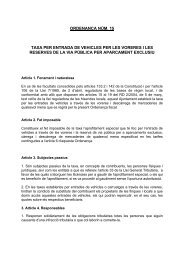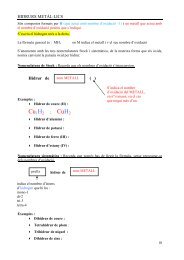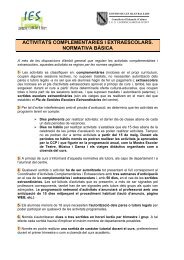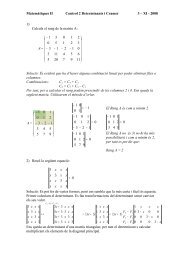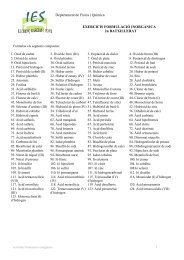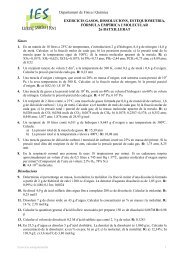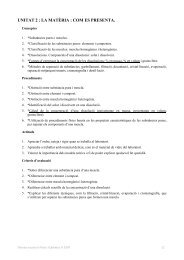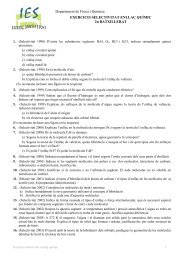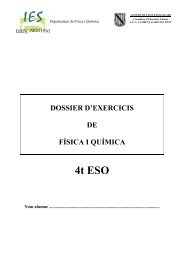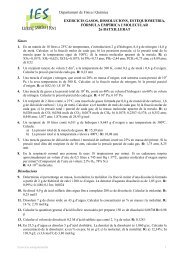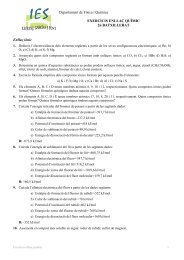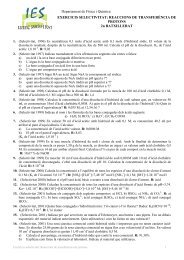Departament de Física i Química EXERCICIS D'EQUILIBRI QUÍMIC ...
Departament de Física i Química EXERCICIS D'EQUILIBRI QUÍMIC ...
Departament de Física i Química EXERCICIS D'EQUILIBRI QUÍMIC ...
You also want an ePaper? Increase the reach of your titles
YUMPU automatically turns print PDFs into web optimized ePapers that Google loves.
Constant d’equilibri<br />
<strong>Departament</strong> <strong>de</strong> <strong>Física</strong> i <strong>Química</strong><br />
<strong>EXERCICIS</strong> D’EQUILIBRI <strong>QUÍMIC</strong><br />
2n BATXILLERAT<br />
1. A 250ºC un recipient <strong>de</strong> 12 litres <strong>de</strong> capacitat conté 0,428 mols <strong>de</strong> pentaclorur <strong>de</strong> fòsfor, 0,125 mols <strong>de</strong> triclorur<br />
<strong>de</strong> fòsfor i 1,71 mols <strong>de</strong> clor en equilibri. Calcula Kc i Kp per la reacció: R: 0,042 mol/l; 1,8 atm<br />
Pentaclorur <strong>de</strong> fòsfor (g) ⇔ triclorur <strong>de</strong> fòsfor (g) + clor (g)<br />
2. Un recipient <strong>de</strong> 2 litres, a 273 K, conté en equilibri 80 g triòxid <strong>de</strong> sofre, 16 g <strong>de</strong> diòxid <strong>de</strong> sofre i 16 g <strong>de</strong><br />
oxigen. Calcula Kc i Kp a aquesta temperatura per l’equilibri:<br />
2 diòxid <strong>de</strong> sofre (g) + oxigen (g) ⇔ 2 triòxid <strong>de</strong> sofre (g)<br />
R: 64 l/mol; 2,86 atm -1<br />
3. En un recipient <strong>de</strong> volum 1 litre a la temperatura <strong>de</strong> 1000 K es troben en equilibri 28,84 g <strong>de</strong> nitrogen, 3,24 g<br />
d’hidrogen i 1,73 g d’amoníac. Determina la Kp <strong>de</strong> l’equilibri: R: 3,42 10 -7 atm -2<br />
3 hidrogen (g) + nitrogen (g) ⇔ 2 amoníac (g)<br />
4. La constant d’equilibri per a la reacció següent a 257ºC és 100 l 2 /mol 2 :<br />
3 hidrogen (g) + nitrogen (g) ⇔ 2 amoníac (g)<br />
Quina és la concentració d’amoníac quan les concentracions <strong>de</strong> hidrogen i nitrogen en l’equilibri són 0,5 mol/l i<br />
1,5 mol/l respectivament? R: 4,3 mol/l<br />
5. Per a la reacció:<br />
Tetraòxid <strong>de</strong> dinitrogen (g) ⇔ 2 diòxid <strong>de</strong> nitrogen (g)<br />
Kp val 0,14 atm, a 25ºC. Un matràs tancat conté una barreja d’aquests gasos en equilibri a aquesta<br />
temperatura. Si la pressió parcial <strong>de</strong>l tetraòxid <strong>de</strong> dinitrogen és <strong>de</strong> 0,25 atm:<br />
a) Quina és la pressió parcial <strong>de</strong>l diòxid <strong>de</strong> nitrogen? R: 0,19 atm<br />
b) Quina és la pressió total <strong>de</strong> la mescla? R:0,44 atm<br />
6. A 400ºC i en un recipient d’un litre es mesclen 0,062 mols d’hidrogen i 0,042 mols <strong>de</strong> io<strong>de</strong>. Quan s’estableix<br />
l’equilibri<br />
hidrogen (g) + io<strong>de</strong> (g)⇔2 iodur d’hidrogen (g)<br />
es formen 0,076 mols d’iodur d’hidrogen. Calcular: a) Kp i Kc; b) la pressió total <strong>de</strong> la mescla en l’equilibri.<br />
R: a) 60,16; b) 5,74 atm<br />
7. La constant d’equilibri per a la següent reacció<br />
Hidrogen (g) + diòxid <strong>de</strong> carboni(g) ⇔ aigua (g) + monòxid <strong>de</strong> carboni (g)<br />
és Kc= 4,4 a 200 K. Calcular les concentracions en l’equilibri si s’introdueixen 1 mol d’hidrogen, 1 mol <strong>de</strong><br />
diòxid <strong>de</strong> carboni i 1 mol d’aigua en un volum <strong>de</strong> 4,68 l. R: [H2 ]=[CO2 ]=0,094 mol/l; [CO]=0,12 mol/l;<br />
[H2O]=0,33 mol/l<br />
8. Quan s’introdueixen 0,25 mols <strong>de</strong> CO2 en un recipient <strong>de</strong> 2 l, a una <strong>de</strong>terminada temperatura, part d’aquest<br />
compost es <strong>de</strong>scompon segons la reacció: 2 CO2 (g) ⇔ 2 CO (g) + O2 (g). La concentració <strong>de</strong>l CO en<br />
l’equilibri és 0,08 mol/l. Calcular: a) Les concentracions <strong>de</strong>ls altres dos compostos en l’equilibri; b) Kc. R: a)<br />
[O2]=0,04 M; [CO2]=0,045 M; b) 0,126 mol/l<br />
9. En un recipient <strong>de</strong> 6 litres introduïm 0,41 mols <strong>de</strong> diòxid <strong>de</strong> carboni i 0,37 mols d’hidrogen. Escalfam el<br />
recipient a 1000 K i s’estableix l’equilibri següent:<br />
Hidrogen (g) + diòxid <strong>de</strong> carboni(g) ⇔ aigua (g) + monòxid <strong>de</strong> carboni (g)<br />
Quan analitzem la mescla <strong>de</strong> reacció trobam que la concentració <strong>de</strong> CO2 en l’equilibri és 0,033 mol/l. Calcula:<br />
a) El valor <strong>de</strong> Kc i Kp a 1000 K R: Kc=Kp=1,36<br />
Exercicis Equilibri químic 1
IES Llorenç Garcías i Font Dep. <strong>Física</strong> i <strong>Química</strong><br />
b) La pressió total <strong>de</strong> la mescla en l’equilibri. R: 10,66 atm<br />
10. En un recipient <strong>de</strong> 10 l introduïm 2 mols <strong>de</strong> compost A y 1 mol <strong>de</strong> compost B. S’encalenteix a 300°C i<br />
s’estableix l’equilibri:<br />
A(s)+3 B(g) ⇔ 2 C(g)<br />
Quan s’estableix l’equilibri el nombre <strong>de</strong> mols <strong>de</strong> B és igual al <strong>de</strong> C. Calcula el nombre <strong>de</strong> mols <strong>de</strong> cada<br />
component en l’equilibri, Kc i Kp i la pressió parcial <strong>de</strong>l componente B. R: A: 1,8 mol; B: 0,4 mol; C: 0,4<br />
mol; 25 l/mol; 0,53 atm -1 ; 1,88 atm.<br />
11. Per la reacció <strong>de</strong> formació <strong>de</strong>l monòxid <strong>de</strong> nitrogen: N2 (g) + O2 (g) ⇔ 2 NO (g), la constat d’equilibri, a<br />
2800ºC, és Kc= 0,012. Quan en un recipient <strong>de</strong> 2 litres s’introdueixen 0,05 mols <strong>de</strong> N2 i 0,05 mols d’O2 i<br />
s’encalenteixen a 2800ºC, calcular a) els mols <strong>de</strong> cada un <strong>de</strong>ls tres gasos a l’equilibri; b) la pressió total <strong>de</strong> la<br />
mescla en l’equilibri. R: a) NO 0,0052 mols; N2=O2= 0,0474 mols; b) 12,6 atm<br />
12. Per l’equilibri<br />
triclorur <strong>de</strong> fòsfor (g) + clor (g) ⇔ Pentaclorur <strong>de</strong> fòsfor (g)<br />
la Kc a 27ºC val 2 mol/l. Calcular la pressió <strong>de</strong>ls gasos en l’equilibri quan reaccionen 0,1 mols <strong>de</strong>l triclorur <strong>de</strong><br />
fòsfor amb 0,2 mols <strong>de</strong> clor en un recipient <strong>de</strong> 20 l a 27ºC. R: 0,37 atm<br />
13. Dins un recipient d’un litre s’introdueixen 0,003 mols <strong>de</strong> tetraòxid <strong>de</strong> dinitrogen. Es termostatitza a 273 K.<br />
Passat un cert temps s’estableix l’equilibri següent:<br />
Tetraòxid <strong>de</strong> dinitrogen (g) ⇔ 2 diòxid <strong>de</strong> nitrogen (g)<br />
Se sap que a l’equilibri el recipient suporta una pressió <strong>de</strong> 0,1 atm. Calculau:<br />
a) nombre <strong>de</strong> mols <strong>de</strong> cada gas a l’equilibri. R: N2O4 0,0015 mols; NO2 0,003 mols<br />
b) Kc. R: 0,006 mol/l<br />
Grau <strong>de</strong> dissociació<br />
14. En un matràs <strong>de</strong> 250 cc, a la temperatura <strong>de</strong> 27ºC, es van introduir 213 mg <strong>de</strong> fosgè. Quan es va haver assolit<br />
l’equilibri COCl2 (g) ⇔ CO (g) + Cl2 (g) la pressió a què va arribar el matràs va ser <strong>de</strong> 230 mm Hg. Calcular:<br />
a) la pressió parcial <strong>de</strong> cada gas. R: P(fosgè)=0,0984 atm; P(CO)= P(Cl2)=0,0984 atm<br />
b) Kc i Kp R: 0,004 mol/l; 0,0984 atm<br />
c) El grau <strong>de</strong> dissociació <strong>de</strong>l fosgè. R: 0,5<br />
15. En un matrau d’un litre introduïm 0,1 mols <strong>de</strong> pentaclorur <strong>de</strong> fòsfor; els encalentim a 250°C i s’estableix el<br />
següent equilibri:<br />
Pentaclorur <strong>de</strong> fòsfor (g) ⇔ triclorur <strong>de</strong> fòsfor (g) + clor (g)<br />
En aquest moment el grau <strong>de</strong> dissociació <strong>de</strong>l pentaclorur <strong>de</strong> fòsfor és <strong>de</strong> 0,84, calcular:<br />
a) Pressió total en l’equilibri. R: 7,89 atm<br />
b) Mols <strong>de</strong> cada component en l’equilibri. R: 0,016 mols <strong>de</strong> PCl5 i 0,084 mols <strong>de</strong> PCl3 i Cl2<br />
c) Kc i Kp. R: 0,441 mol/l; 18,91 atm<br />
16. A 200°C, la <strong>de</strong>scomposició <strong>de</strong>l PCl5 té una constant d’equilibri Kp=0,3075 atm. Calcular Kc i el grau <strong>de</strong><br />
dissociació que presenten 50 g <strong>de</strong> PCl5 introduïts en un recipient <strong>de</strong> 2 litres. R: 0,00793 mol/l; 0,23<br />
17. En un matrau d’1 litre introduïm 46 g <strong>de</strong> tetraòxid <strong>de</strong> dinitrogen. La constant <strong>de</strong> l’equilibri<br />
Tetraòxid <strong>de</strong> dinitrogen (g) ⇔ 2 diòxid <strong>de</strong> nitrogen (g)<br />
és Kc=0,125 mol/l. Calcular el grau <strong>de</strong> dissociació <strong>de</strong>l tetraòxid <strong>de</strong> dinitrogen. R: 0,22<br />
18. En un matrau d’un litre introduïm 0,1 mols <strong>de</strong> pentaclorur <strong>de</strong> fòsfor; els encalentim a 250°C i s’estableix el<br />
següent equilibri:<br />
Pentaclorur <strong>de</strong> fòsfor (g) ⇔ triclorur <strong>de</strong> fòsfor (g) + clor (g)<br />
Exercicis Equilibri químic 2
IES Llorenç Garcías i Font Dep. <strong>Física</strong> i <strong>Química</strong><br />
En aquesta temperatura el grau <strong>de</strong> dissociació <strong>de</strong>l pentaclorur <strong>de</strong> fòsfor és <strong>de</strong> 0,48, calcular:<br />
a) La pressió a l’interior <strong>de</strong>l matrau. R: 6,35 atm<br />
b) El nombre <strong>de</strong> mols <strong>de</strong> cada component en l’equilibri. R: 0,052 mols <strong>de</strong> PCl5 i 0,048 mols <strong>de</strong> PCl3 i Cl2.<br />
c) Kc. R: 0,044 mol/l<br />
19. En un recipient <strong>de</strong> 1,3 litres <strong>de</strong> capacitat introduïm 2,6 g <strong>de</strong>l tetraòxid <strong>de</strong> dinitrogen a 27ºC, assolint en<br />
l’equilibri:<br />
Tetraòxid <strong>de</strong> dinitrogen (g) ⇔ 2 diòxid <strong>de</strong> nitrogen (g)<br />
una pressió <strong>de</strong> 0.6 atm. Calcula el grau <strong>de</strong> dissociació. R: 0,132<br />
Quocient <strong>de</strong> reacció<br />
20. A 350ºC per la reacció:<br />
Pentaclorur <strong>de</strong> fòsfor (g) ⇔ triclorur <strong>de</strong> fòsfor (g) + clor (g)<br />
el valor <strong>de</strong> Kc és 0,58 mol/l. En un recipient <strong>de</strong> 25 l existeix una mescla formada per 2 mols <strong>de</strong> clor, 1,5 mols<br />
<strong>de</strong> triclorur <strong>de</strong> fòsfor i 0,15 mols <strong>de</strong> pentaclorur <strong>de</strong> fòsfor:<br />
a) Calcula les concentracions en l’equilibri. R: PCl5 0,00784 mol/l; PCl3 0,05816 mol/l; Cl2 0,07816 mol/l<br />
b) Com influirà en l’equilibri un augment <strong>de</strong> pressió? i una disminució <strong>de</strong> temperatura si la reacció és<br />
endotèrmica?<br />
21. A 425ºC la Kc a l’equilibri<br />
hidrogen (g) + io<strong>de</strong> (g)⇔2 iodur d’hidrogen (g)<br />
val 54,8. Calcula les concentracions <strong>de</strong> l’equilibri si al reactor <strong>de</strong> 20 litres <strong>de</strong> capacitat s’introdueixen 15 mols<br />
<strong>de</strong> io<strong>de</strong>, 2 mols d’hidrogen i 25 mols <strong>de</strong> iodur d’hidrogen. R: [I2]=0,698 M; [H2]=0,048 M; [HI]=1,354 M<br />
22. Per la reacció<br />
2 iodur d’hidrogen (g) ⇔ hidrogen (g) + io<strong>de</strong> (g)<br />
Kc=0,018 a 700ºC:<br />
a) Determina si una mescla <strong>de</strong> 1 mol <strong>de</strong> HI, 1 mol <strong>de</strong> H2 i 2 moles <strong>de</strong> I2 està en equilibri a 700ºC.<br />
b) Una segona mescla a igual temperatura, està formada per 0.2 moles <strong>de</strong> HI, 0.1 mols <strong>de</strong> H2 i 0.5 mols <strong>de</strong> I2 .<br />
Si no està en equilibri, en quin sentit transcurrirà la reacció?<br />
c) Calcula per la segona mescla, el nombre <strong>de</strong> mols <strong>de</strong> cada component en l’equilibri. R: HI: 0,386 mol; H2<br />
0,007 mol; I2 0,407 mol<br />
23. La constant d’equilibri per a la reacció <strong>de</strong> dissociació <strong>de</strong> tetraòxid <strong>de</strong> dinitrogen és Kc=0,212 mol/l a 100ºC:<br />
Tetraòxid <strong>de</strong> dinitrogen (g) ⇔ 2 diòxid <strong>de</strong> nitrogen (g)<br />
En una mescla <strong>de</strong> tots dos gasos a 100ºC s’ha trobat que la concentració <strong>de</strong> tetraòxid <strong>de</strong> dinitrogen és 0,10<br />
mol/l i la concentració <strong>de</strong> diòxid <strong>de</strong> nitrogen és 0,11 mol/l:<br />
a) La mescla es troba en equilibri?<br />
b) Com s’ha <strong>de</strong> modificar la concentració <strong>de</strong> diòxid <strong>de</strong> nitrogen per què adquireixi l’equilibri?<br />
c) Quines són les concentracions <strong>de</strong> diòxid <strong>de</strong> nitrogen i tetraòxid <strong>de</strong> nitrogen en l’equilibri? R: b) augmenta<br />
0,026 mol/l; c) diòxid <strong>de</strong> nitrogen 0,136 mol/l; tetraòxid <strong>de</strong> dinitrogen 0,087 mol/l.<br />
24. La constant d’equilibri per a la reacció següent és <strong>de</strong> Kc= 0,9 a 700ºC:<br />
Diòxid <strong>de</strong> sofre (g) + diòxid <strong>de</strong> nitrogen (g) ⇔ triòxid <strong>de</strong> sofre (g) + monòxid <strong>de</strong> nitrogen (g)<br />
En un recipient <strong>de</strong> 0,75 litres s’introdueixen 0,003 mols <strong>de</strong> cadascuna <strong>de</strong> les quatre substàncies.<br />
Quines concentracions tindrà quan assoleixi l’equilibri?<br />
R: [diòxid <strong>de</strong> sofre]=[diòxid <strong>de</strong> nitrogen]=0,0041 M; [triòxid <strong>de</strong> sofre]=[monòxid <strong>de</strong> nitrogen]=0,0039 M<br />
Exercicis Equilibri químic 3
IES Llorenç Garcías i Font Dep. <strong>Física</strong> i <strong>Química</strong><br />
25. La constant d’equilibri per a la reacció<br />
aigua (g) + monòxid <strong>de</strong> carboni (g) ⇔ Hidrogen (g) + diòxid <strong>de</strong> carboni(g)<br />
és <strong>de</strong> 5,1 a 800 K. Si s’introdueixen inicialment 4 mols d’hidrogen, 2 mols <strong>de</strong> diòxid <strong>de</strong> carboni, 1 mol d’aigua<br />
i 1 mol <strong>de</strong> monòxid <strong>de</strong> carboni:<br />
a) quants mols <strong>de</strong> monòxid <strong>de</strong> carboni tindrem quan s’arribi a l’equilibri? R: 1,172 mols<br />
b) Com afecta a l’equilibri:<br />
1. una disminució <strong>de</strong> la pressió <strong>de</strong>l sistema<br />
2. una disminució <strong>de</strong>l volum.<br />
3. l’addició d’un catalitzador.<br />
26. La constant d’equilibri per a la reacció<br />
aigua (g) + monòxid <strong>de</strong> carboni (g) ⇔ Hidrogen (g) + diòxid <strong>de</strong> carboni(g)<br />
és <strong>de</strong> 5,1 a 800 K. Si 1 mol <strong>de</strong> monòxid <strong>de</strong> carboni i 1 mol d’aigua s’escalfen a 800 K en un recipient <strong>de</strong> 50<br />
litres, calcula:<br />
a) Quants mols <strong>de</strong> monòxid <strong>de</strong> carboni que<strong>de</strong>n sense reaccionar quan s’estableix l’equilibri? R: 0,31 mol<br />
b) La pressió parcial <strong>de</strong> cada gas i la pressió total al recipient. R: P(CO)=0,403 atm; P(H2O)=0,403 atm;<br />
P(H2)= P(CO2)=0,909 atm; Ptotal=2,624 atm<br />
c) Si s’introdueixen inicialment al mateix recipient i a la mateixa temperatura 4 mols d’hidrogen, 2 mols <strong>de</strong><br />
diòxid <strong>de</strong> carboni, 2 mol d’aigua i 2 mol <strong>de</strong> monòxid <strong>de</strong> carboni, quants mols <strong>de</strong> monòxid <strong>de</strong> carboni<br />
tindrem quan s’arribi a l’equilibri? R: 1,49 mols<br />
Modificacions <strong>de</strong> l’estat d’equilibri: Principi <strong>de</strong> Le Chatelier<br />
27. Donat l’equilibri:<br />
Br 2 (g)+CO(g) ⇔ COBr 2 (g)<br />
indicar l’efecte que es produirà sobre la posició <strong>de</strong> l’equilibri quan:<br />
a) S’augmenta la pressió.<br />
b) S’afeig CO(g)<br />
c) S’augmenta el volumen <strong>de</strong>l recipient.<br />
28. A una <strong>de</strong>terminada temperatura el pentaclorur <strong>de</strong> fòsfor es dissocia en triclorur <strong>de</strong> fòsfor i clor. Quan<br />
s’estableix l’equilibri d’aquesta reacció, duita a terme dins un recipient <strong>de</strong> 10 litres, es comproba que les<br />
concentracions són 0,8 mol/l <strong>de</strong> pentaclorur <strong>de</strong> fòsfor, 0,2 mol/l <strong>de</strong> triclorur <strong>de</strong> fòsfor i 0,2 mol/l <strong>de</strong> clor:<br />
Pentaclorur <strong>de</strong> fòsfor (g) ⇔ triclorur <strong>de</strong> fòsfor (g) + clor (g)<br />
a) Calcula la Kc per l’equilibri en aquestes condicions. R: 0,05 mol/l<br />
b) Indicar cap on es <strong>de</strong>splaçarà l’equilibri quan s’afegeixen 2 mols <strong>de</strong> clor. Calcula les noves concentracions a<br />
l’equilibri. R: PCl5 0,869 mol/l; PCl3 0,131 mol/l; Cl2 0,331 mol/l<br />
29. En la reacción exotèrmica:<br />
monòxid <strong>de</strong> carboni (g) + 2 hidrogen (g) ⇔ metanol (g)<br />
A 300°C les presions parcials en l’equilibri són: P(monòxid <strong>de</strong> carboni)=4,2 atm; P(hidrogen)=1,75 atm;<br />
P(metanol)=0,12 atm. Calcula els valors <strong>de</strong> Kp i Kc a aquesta temperatura. R: 0,0093 atm -2 ; 20,6 l 2 /mol 2<br />
Indicar cap on es <strong>de</strong>splaça l‘equilibri i com variarà la constant d’equilibri si disminueix:<br />
a) la temperatura.<br />
b) la pressió total.<br />
c) la pressió parcial <strong>de</strong>l metanol.<br />
d) la pressió parcial <strong>de</strong>l monòxid <strong>de</strong> carboni<br />
e) S’afegeix Ar<br />
Exercicis Equilibri químic 4
IES Llorenç Garcías i Font Dep. <strong>Física</strong> i <strong>Química</strong><br />
30. Donat el sistema en equilibri:<br />
6 CO2 (g) + 6 H2O (l) ⇔ C6H12O6 (s) + 6 O2 (g) ∆H=2816 kJ<br />
a) Expressar la constant d’equilibri Kp.<br />
b) Predir com se modifica la quantitat <strong>de</strong> glucosa en l’equilibri quan:<br />
- S’augmenta la temperatura.<br />
- S’introdueix un catalitzador.<br />
31. En un recipient tancat s’efectua la reacció A (g) + 2 B (g) ⇔ 2 C (g), que és exotèrmica i que es troba en<br />
equilibri a la pressió i temperatura normals. Com variarà la Kp d’aquest equilibri a) si s’augmenta la<br />
temperatura b) si la concentració <strong>de</strong> A augmenta c) si s’addiciona un catalitzador.<br />
32. La reacció <strong>de</strong> <strong>de</strong>scomposició d’hidrogensulfur d’amoni és una reacció endotèrmica. En un recipient tancat<br />
s’introdueix una <strong>de</strong>terminada quantitat d’hidrogensulfur d’amoni (s) i s’assoleix l’equilibri següent a 350ºC:<br />
hidrogensulfur d’amoni (s) ⇔ amoníac (g) + sulfur d’hidrogen (g) ∆H>0<br />
Indica l’efecte que produeix sobre la pressió parcial d’amoníac i sobre el grau <strong>de</strong> dissociació <strong>de</strong><br />
l’hidrogensulfur d’amoni cadascuna <strong>de</strong> les modificacions següents:<br />
a) Addició <strong>de</strong> sulfur d’hidrogen (g)<br />
b) Addició d’una petita quantitat d’hidrogensulfur d’amoni<br />
c) Addició d’una gran quantitat d’hidrogensulfur d’amoni<br />
d) Increment <strong>de</strong> la temperatura<br />
e) Duplicació <strong>de</strong>l volum <strong>de</strong>l recipient<br />
f) S’afegeix Ne.<br />
33. El clor es pot obtenir per oxidació <strong>de</strong> clorur d’hidrogen en fase gasosa:<br />
4 clorur d’hidrogen (g) + oxigen (g) ⇔ 2 aigua (g) + 2 clor (g)<br />
Per incrementar el rendiment en l’obtenció <strong>de</strong> Cl2 (g) el més convenient és:<br />
a) disminuir la pressió<br />
b) augmentar la pressió<br />
c) reduir la concentració <strong>de</strong> clorur d’hidrogen<br />
d) augmentar la concentració d’aigua<br />
34. En un recipient tancat es troben en equilibri 0,32 mols <strong>de</strong> io<strong>de</strong>, 0,32 mols d’hidrogen i 2,36 mols d’iodur<br />
d’hidrogen.<br />
hidrogen (g) + io<strong>de</strong> (g)⇔2 iodur d’hidrogen (g)<br />
Mantenint constant la temperatura, s’introdueix al recipient un mol més d’hidrogen molecular:<br />
a) Com reaccionarà el sistema?<br />
b) Quants mols <strong>de</strong> cada gas hi haurà quan s’estableixi un nou equilibri? R: 1,122 mol d’hidrogen; 0,122 mol<br />
<strong>de</strong> io<strong>de</strong> i 2,756 mol <strong>de</strong> iodur d’hidrogen.<br />
35. Calcula el valor <strong>de</strong> Kc, a 500ºC, per a l’equilibri:<br />
Òxid d’estany (IV) (s) + 2 hidrogen (g) ⇔ estany (s) + 2 aigua (g)<br />
Sabent que l’anàlisi d’una mescla d’aquestes quatre substàncies, en equilibri, va donar<br />
[aigua]=[hidrogen]=0,1M. S’hi afegeix hidrogen molecular fins que la seva concentració augmenta fins a 0,2<br />
M. Quines seràn les concentracions <strong>de</strong>ls gasos quan es restableixi l’equilibri? R: Kc=1; [H2O]=[H2]= 0,15 M<br />
36. En un recipient <strong>de</strong> 2 litres es posen 198 grams <strong>de</strong> fosgen gas (COCl2) i s’escalfen fins a <strong>de</strong>scompondre’ls<br />
parcialment:<br />
fosgen (g) ⇔ monòxid <strong>de</strong> carboni (g) + clor (g)<br />
Exercicis Equilibri químic 5
IES Llorenç Garcías i Font Dep. <strong>Física</strong> i <strong>Química</strong><br />
Quan s’aconsegueix l’equilibri a una <strong>de</strong>terminada temperatura, la concentració <strong>de</strong> monòxid <strong>de</strong> carboni és <strong>de</strong><br />
0,4 mol/l. S’afegeix més fosgen al recipient, i quan es restableix <strong>de</strong> nou l’equilibri a la mateixa temperatura la<br />
seva concentració és d’1,6 M. Com s’haurà modificat la concentració <strong>de</strong> monòxid <strong>de</strong> carboni? R: haurà<br />
augmentat 0,253 M<br />
37. El iodur d’hidrogen es <strong>de</strong>scompon segons l’equilibri següent:<br />
io<strong>de</strong> (g) + hidrogen (g) ⇔ 2 iodur d’hidrogen (g)<br />
Dins un recipient tancat en equilibri es troben: 0,38 mols <strong>de</strong> io<strong>de</strong> (g), 0,08 mols d’hidrogen (g) i 1,24 mols <strong>de</strong><br />
iodur d’hidrogen (g).<br />
S’afegeixen 0,3 mols d’hidrogen (g) i novament s’estableix l’equilibri.<br />
Calculau el nombre <strong>de</strong> mols <strong>de</strong> cada gas a l’equilibri (que s’ha establert <strong>de</strong>sprés <strong>de</strong> l’addició <strong>de</strong> l’hidrogen).<br />
R: 1,56 mols <strong>de</strong> iodur d’hidrogen; 0,22 mols d’hidrogen; 0,22 mols <strong>de</strong> io<strong>de</strong><br />
38. Per al següent equilibri: Pentaclorur <strong>de</strong> fòsfor (g) ⇔ Triclorur <strong>de</strong> fòsfor (g) + clor (g) ∆H
IES Llorenç Garcías i Font Dep. <strong>Física</strong> i <strong>Química</strong><br />
b) P(amoníac)=30,4 mm Hg i P(clorur d’hidrogen)=22,8 mm Hg<br />
En cas afirmatiu calcula les pressions parcials un cop assolit l’equilibri.<br />
R: a) Si; P(amoníac)=0,13 atm,: P(clorur d’hidrogen)=0,43 atm; b) No<br />
43. Per a la reacció <strong>de</strong> <strong>de</strong>scomposició <strong>de</strong>l clorur d’amoni sòlid:<br />
Clorur d’amoni (s) ⇔ amoníac (g) + clorur d’hidrogen (g)<br />
La constant d’equilibri Kp val 6 10 -9 atm 2 a 400 K. Calcula les pressions parcials d’amoníac i <strong>de</strong> clorur<br />
d’hidrogen produïts en la <strong>de</strong>scomposició d’una mostra <strong>de</strong> clorur d’amoni sòlid, a 400 K, un cop assolit<br />
l’equilibri. R: 7,75 10 -5 atm<br />
44. A 1000ºC la reacció<br />
diòxid <strong>de</strong> carboni (g) + carboni (s) ⇔ 2 monòxid <strong>de</strong> carboni (g)<br />
té una Kp=1,65 atm. Si en equilibri, a aquesta temperatura, la pressió total és <strong>de</strong> 5 atm, calcular el percentatge<br />
<strong>de</strong> diòxid <strong>de</strong> carboni que ha reaccionat. R: 27,6 %<br />
45. El tetraòxid <strong>de</strong> dinitrogen es dissocia en diòxid <strong>de</strong> nitrogen assolint un equilibri entre ambos gasos.<br />
Tetraòxid <strong>de</strong> dinitrogen (g) ⇔ 2 diòxid <strong>de</strong> nitrogen (g)<br />
A 27ºC i 1 atm el tetraòxid <strong>de</strong> dinitrogen està dissociat un 20%. Calcula: a) Kp en aquesta temperatura; b) el<br />
grau <strong>de</strong> dissociació quan introduïm 138 g <strong>de</strong> tetraòxid <strong>de</strong> dinitrogen en un recipient <strong>de</strong> 30 l a 27ºC. R: a)0.166<br />
atm; b)0.166<br />
46. A 25°C, la constant Kp per la <strong>de</strong>scomposició <strong>de</strong>l tetraòxid <strong>de</strong> dinitrogen en diòxid <strong>de</strong> nitrogen és igual a<br />
0,141atm.<br />
Tetraòxid <strong>de</strong> dinitrogen (g) ⇔ 2 diòxid <strong>de</strong> nitrogen (g)<br />
Calcular la pressió total dins un recipient que conté els dos gasos en equilibri si el tetraòxid està dissociat un<br />
50%. R: 0,106 atm.<br />
47. A 300°C i 1,5 atm <strong>de</strong> pressió total, el pentaclorur <strong>de</strong> fòsfor gas està dissociat en un 80% en triclorur <strong>de</strong> fòsfor i<br />
clor.<br />
Pentaclorur <strong>de</strong> fòsfor (g) ⇔ triclorur <strong>de</strong> fòsfor (g) + clor (g)<br />
Calcular:<br />
a) Kp i Kc. R: 2,66 atm; 0,057 mol/l<br />
b) Kp a 300°C i 3 atm R: 2,66 atm<br />
48. A la temperatura <strong>de</strong> 400°C i pressió <strong>de</strong> 10 atm, l’amoníac està dissociat en un 90%:<br />
2 amoníac (g) ⇔ nitrogen (g) + 3 hidrogen (g).<br />
Calcular:<br />
a) Kc i Kp. R: 3073 atm 2 ; 1 mol 2 /l 2<br />
b) Si ∆H=-92,4 kJ què val ∆S. R: -0,137 kJ/K<br />
49. A 1000ºC la reacció<br />
Tetraòxid <strong>de</strong> dinitrogen (g) ⇔ 2 diòxid <strong>de</strong> nitrogen (g)<br />
té una Kp=1,65 atm. Si en l’equilibri, a aquesta temperatura, la pressió total és <strong>de</strong> 5 atm, calcular el grau <strong>de</strong><br />
dissociació <strong>de</strong>l tetraòxid <strong>de</strong> dinitrogen. R: 0,276<br />
50. A 1000 K i 1 atm <strong>de</strong> pressió total el triòxid <strong>de</strong> sofre gas està dissociat un 40% en diòxid <strong>de</strong> sofre gas i oxigen<br />
gas.<br />
triòxid <strong>de</strong> sofre (g) ⇔ diòxid <strong>de</strong> sofre (g) + 1/2 oxigen (g)<br />
Calcula en l’equilibri les pressions parcials <strong>de</strong>ls gasos i Kp. R: P(oxigen)=0,16 atm; P(diòxid <strong>de</strong> sofre)=0,33<br />
atm; P(triòxid <strong>de</strong> sofre)=0,5 atm; 0,27 atm 1/2<br />
Exercicis Equilibri químic 7
IES Llorenç Garcías i Font Dep. <strong>Física</strong> i <strong>Química</strong><br />
51. A la temperatura <strong>de</strong> 100ºC i 1 atm <strong>de</strong> pressió, el compost ZY està dissociat un 10% segons la reacció:<br />
ZY (g) ⇔ Z (g) + Y (g)<br />
Calcula el grau <strong>de</strong> dissociació si se manté constant la temperatura i s’augmenta la pressió fins 5 atm. R: 0,048<br />
52. A 200ºC i 1 atm el pentaclorur <strong>de</strong> fòsfor es dissocia un 48,5%. Calcula el grau <strong>de</strong> dissociació a la mateixa<br />
temperatura però a una pressió <strong>de</strong> 10 atm. R: 0,17<br />
Concepte d’equilibri<br />
53. Per a la reacció <strong>de</strong> dissociació <strong>de</strong> l’oxigen molecular:<br />
O2 (g) ⇔ 2 O (g)<br />
Kc val 10 -34 mol/l, a 25ºC. Raona si l’oxigen <strong>de</strong> l’habitació es troba en forma atòmica o molecular.<br />
54. Indica quina d’aquestes reaccions està més <strong>de</strong>splaçada cap a la dreta:<br />
2 aigua (g) + oxigen (g) ⇔ 2 aigua oxigenada (g) Kc=9·10 80<br />
2 bromur d’hidrogen (g) ⇔ hidrogen (g) + brom (g) Kc=7·10 -20<br />
silici (g) + oxigen (g) ⇔ diòxid <strong>de</strong> silici (g) Kc=9·10 142<br />
55. Indica si les següents frases són verta<strong>de</strong>res o falses i justifica la resposta:<br />
a) Si la constant d’equilibri d’una reacció és elevada, significa que els productes s’obtenen ràpidament.<br />
b) La constant d’equilibri d’una reacció és constant, és a dir, no <strong>de</strong>pèn <strong>de</strong> res, excepte <strong>de</strong> la naturalesa <strong>de</strong> la<br />
reacció en qüestió.<br />
c) Quan una reacció reversible aconsegueix l’equilibri, encara que la quantitat total <strong>de</strong> productes i reactius no<br />
varia, se segueix produint les reaccions directa i inversa.<br />
56. La constant d’equilibri <strong>de</strong> la reacció representada per l’equació química:<br />
2 hidrogen (g) + monòxid <strong>de</strong> carboni (g) ⇔ metanol (g)<br />
a 425ºC val Kc= 300 l 2 /mol 2 . Quina és la constant d’equilibri per a aquesta reacció si es representa per mitjà <strong>de</strong><br />
les equacions següents?<br />
a) hidrogen (g) + 1/2 monòxid <strong>de</strong> carboni (g) ⇔ 1/2 metanol (g)<br />
b) metanol (g) ⇔ 2 hidrogen (g) + monòxid <strong>de</strong> carboni (g)<br />
R: a) 17,32 l/mol; 0,0033 mol 2 /l 2<br />
57. Estableix les relacions matemàtiques que existeixen entre Ka i la resta <strong>de</strong> constants d’equilibri:<br />
a) hidrogen (g) + io<strong>de</strong> (g) ⇔ 2 iodur d’hidrogen (g) Ka<br />
b) 2 iodur d’hidrogen (g) ⇔ hidrogen (g) + io<strong>de</strong> (g) Kb<br />
c) iodur d’hidrogen (g) ⇔ 1/2 hidrogen (g) + 1/2 io<strong>de</strong> (g) Kc<br />
d) 1/2 hidrogen (g) + 1/2 io<strong>de</strong> (g) ⇔ iodur d’hidrogen (g) Kd<br />
58. Determina la constant d’equilibri a 1120 K <strong>de</strong> l’equilibri:<br />
C (s) + CO2 (g) + 2 Cl2 (g) ⇔ 2 COCl2 (g)<br />
A partir <strong>de</strong> les constants d’equilibri, a 1120 K, següents:<br />
C (s) + CO2 (g) ⇔ 2 CO (g) Kp1= 1,3·10 14 atm<br />
CO (g) + Cl2 (g) ⇔ COCl2 (g) Kp2= 6·10 -3 atm -1<br />
R: 4,68·10 9 atm -1<br />
59. Atesos els equilibris químics representats per les equacions següents:<br />
1) amoníac (g) + 5/4 oxigen (g) ⇔ monòxid <strong>de</strong> nitrogen (g) + 3/2 aigua (g) Kc1<br />
2) diòxid <strong>de</strong> nitrogen (g) ⇔ monòxid <strong>de</strong> nitrogen (g) + 1/2 oxigen (g) Kc2<br />
Exercicis Equilibri químic 8
IES Llorenç Garcías i Font Dep. <strong>Física</strong> i <strong>Química</strong><br />
calcula en funció <strong>de</strong> Kc1 i Kc2, el valor <strong>de</strong> la constant d’equilibri, Kc3 <strong>de</strong>l procés representat per l’equació<br />
químic següent:<br />
3) 2 amoníac (g) + 7/2 oxigen (g) ⇔ 2 diòxid <strong>de</strong> nitrogen (g) + 3 aigua (g) Kc3<br />
R: K 2 c1/K 2 c2<br />
60. Ateses les equacions químiques següents:<br />
1) 2 diòxid <strong>de</strong> carboni (g) ⇔ 2 monòxid <strong>de</strong> carboni (g) + oxigen (g); Kc1<br />
2) 2 diòxid <strong>de</strong> sofre (g) + oxigen (g) ⇔ 2 triòxid <strong>de</strong> sofre (g); Kc2<br />
indica en funció <strong>de</strong> Kc1 i Kc2, l’expressió <strong>de</strong> la constant d’equilibri <strong>de</strong> l’equilibri químic representat per<br />
l’equació següent:<br />
R: Kc3=1/K 1/2 c1 K 1/2 c2<br />
3) triòxid <strong>de</strong> sofre (g) + monòxid <strong>de</strong> carboni (g) ⇔ diòxid <strong>de</strong> sofre (g) + diòxid <strong>de</strong> carboni (g); Kc3<br />
Exercicis Equilibri químic 9



